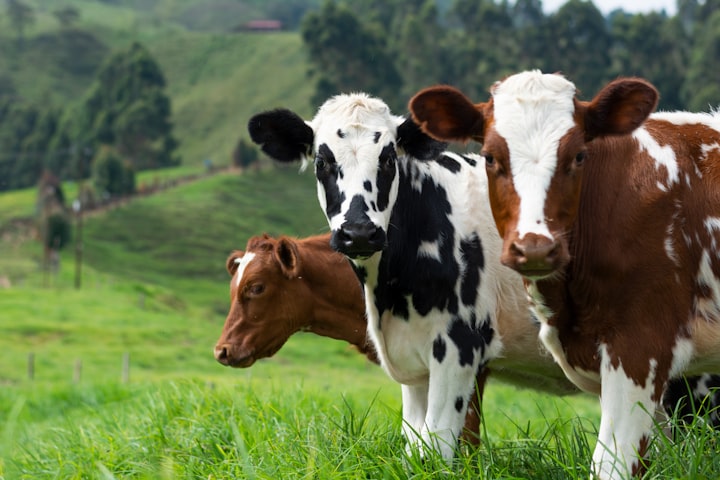How Does a 1,200 Pound Cow Get Enough Protein?
A key fact you learned about cows as a child is wrong.

As a child, I learned about cows and other herbivores. I learned that cows ate grass, that they produced milk for my breakfast cereal, and that they have four stomachs, while humans only have one. I learned that we raised male cows to make steaks and hamburgers, and that we raised female cows to get milk, which we could turn into all sorts of delicious foods, like processed American cheese singles and ice cream. (I did not have the healthiest diet as a child.)
I grew up in a fairly suburban area, so I didn’t see a cow up close for several years, not until an expedition to a farm roughly around age ten or eleven. I was a fairly small child, and I marveled at the size of these large, slowly grazing creatures that ambled past me, looked at me out of one placid eye, and constantly munched and chewed on mouthfuls of grass or hay.
After building up my courage, I gathered a handful of straw and held it out to the nearest cow. I was delighted when the animal used large lips to pluck the straw from my fingers with surprising dexterity, incorporating the straw into the bundle of wet grass already being masticated in her mouth.
In elementary and middle school classes, my classmates and I learned about the differences between herbivores and carnivores. “Herbivores,” the teacher told us, “eat only plants — they’re vegetarians. They get all the nutrients from the plants that they eat.”
It made sense. Cows spent a lot of time grazing on grass, and I loved the simple elegance of the flowchart — sunlight makes plants grow, which are food for herbivores, which in turn feed carnivores. A pyramid of an ecosystem, just like the food pyramid printed on posters in our lunchroom.
Unfortunately, that food pyramid turned out to be wrong. And similarly, the idea that cows could get all their nutrients from grass just didn’t make sense, particularly with regards to protein.
Grass, corn, and wheat straw (hay), some of the main foods given to cattle, aren’t very rich in protein. In fact, they really don’t contain much nutrition at all. Most of the calories are locked away in cellulose, the main fiber produced by plants, a long, stringy molecule that our digestive enzymes can’t break down.
Simply put, there’s not enough nutrition or protein in grass to feed a cow, even if you could unlock 100% of the nutrients.
So how does a cow get protein?
A cow is not a vegetarian. A cow is a living, breathing fermentation tank.
Brewing protein

If you remember learning that a cow is a herbivore in elementary school, you may remember one other fact about cows; namely, they have four stomachs.
As a child, the reason why cows have four stomachs was probably explained as the way that the cow digests grass. I remember this explanation: “grass is really tough to break down, so it has to go through four stomachs, where it ferments and degrades so the cow can absorb the nutrients!”
It’s a good explanation, but it’s largely incorrect.
In truth, the majority of calories, nutrients, and protein that a cow absorbs comes not from the grass or hay it eats, but from trillions of little inhabitants living in its stomachs, going through a constant frenzy of growth, division, multiplying, and eventually dying.
A cow doesn’t eat grass. A cow eats bacteria, which grow on the grass that it ferments in its stomach. The reason that a cow eats grass is to provide a food source for its real meal — the bacteria. It’s the bacteria that break down the hard-to-digest cellulose in grass and convert it into a plethora of different amino acids, which in turn become the building blocks for creating a 1,200 pound animal.
In fact, this means that a cow is rather similar to a beer brewer; both creatures put plant material into a dark, wet, fairly anaerobic (oxygen-starved) environment, with the end goal of growing microbes and producing a tastier and more nutritious end product.
So, why four stomachs?
You remember how cows have four stomachs — it’s the main fact that you know about cows, aside from the fact that they get all their nutrients from plants (incorrect) and that they turn into delicious McDonalds hamburgers (questionable). But if those four stomachs aren’t to make sure that there’s enough time for the grass to fully break down, what do they do?
As it turns out, even this fact isn’t quite right — it’s better to think of a cow as having one big stomach with four different compartments. Cows are in a group of plant-eaters called foregut fermenters, which means that microbial digestion of the raw plant material happens at the beginning of their digestive tract. (Other animals, like rabbits and horses, are hindgut fermenters, meaning that microbial digestion happens towards the end of their digestive tract.)
In the first chamber, the rumen, the freshly-consumed plant material is mixed with saliva, starting the breakdown process to open up plant cells so that microbes can get inside and break down the cellulose and other molecules. The rumen is constantly mixing; the cow regurgitates some of this back up into its mouth and chews it (the cud), further adding to the breakdown process. This is why cows in fields always have their mouths in motion, like they’re gossiping idly about you.
In second and third chambers of the cow’s stomach, the mass of plant bits and microbes is drained of water and fatty acids. It isn’t until the mass reaches the fourth component of the stomach, the abomasum, that enzymes and acids begin ripping apart the dead and dying microbes so their nutrients can be absorbed in the cow’s intestine.
This setup, with microbial breakdown of the food happening at the beginning of the digestive system, makes cows surprisingly efficient when compared to hindgut fermenters such as horses or rabbits. The microbes have a much longer time to break down the food, and the animal has much more time to absorb the nutrients.
I can’t believe it. Cows don’t actually get most of their nutrients from the hay and grass they eat. What do I tell my children?
Thankfully, knowledge is power, and thanks to ubiquitous advertisements for probiotics on television, it’s easy to understand the idea that your gut is full of bacteria that help keep you healthy and regular.
Just explain to your wide-eyed children that cows, like us, have bacteria in their stomachs. Cows eat grass, which the bacteria use to grow. The cow then eats those bacteria to get vital nutrients!
Make sure to emphasize to your children that, just because cows can eat bacteria, it doesn’t mean that children should do so as well. They still need to wash their hands before dinner.

But next time you see a cow out in a field while driving between cities, or when you’re next at the grocery store perusing the hamburger options in the meat aisle, remember that those big, muscular animals aren’t built from grass, hay, and wheat.
Just like a massive blue whale grows from a diet of tiny krill, the big, bulky, hearty cows grow from a diet of untold trillions of microbes, bacteria that they culture in their stomachs, feed, and eventually devour.
And think: if we’ve only recently discovered what microbes can do for cows, imagine the future discoveries about what they do for us!
About the Creator
Sam Westreich
PhD in genetics, bioinformatician, scientist at a Silicon Valley startup. Microbiome is the secret of biology that we’ve overlooked until now.






Comments
There are no comments for this story
Be the first to respond and start the conversation.